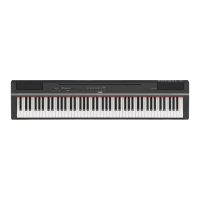P-125a Owner’s Manual
13
Reference
Reference
Selecting & Playing Voices
The instrument has a wide variety of Voices, or instrument sounds, for your enjoyment, including Piano and
Organ.
The Voices of the instrument are conveniently divided into
specific groups and each of them are assigned to the Voice
buttons.
1
Press a Voice button (page 9).
A Voice is called up from the selected group. Try
playing the keyboard and listening to the sound.
Pressing the same Voice button selects the Voices
in the group in order. For details, refer to the Voice
List below. When the first Voice in the group is
selected, a Variation lamp is off. When a Variation
Voice 1 – 3 is selected, the corresponding varia-
tion lamp lights up.
Voice List
Refer to the “Voice List (Detailed)” on page 26 for
more information on the characteristics of each
preset Voice.
When this is set to on, speaker sound will be opti-
mized for playing the keyboard placed on the table or
desk. This function is effective only from the sound
output of the instrument speakers. Turn off when you
play the keyboard installed on the stand.
Default setting: off
This function is particularly useful when you want not
only notes played very loud, but also those played
softly, to be clearly audible.
Default setting: off
* Refer to the printing above the keyboard (SOUND BOOST
OFF/ON).
Selecting a Voice
• The last selected Voice in the selected group will be called up when the
Voice button is pressed. This will be reset to the first Voice when you
turn off the power.
• Pressing [+BASS] turn on the Split function (page 15).
Voice Button
(Group)
Voice Name Variation
[PIANO]
Grand Piano
Live Grand
1
Ballad Grand
2
Bright Grand
3
[E.PIANO]
Stage E.Piano
DX E.Piano
1
Vintage E.Piano
2
Synth Piano
3
[ORGAN]
Jazz Organ
Rock Organ
1
Organ Principal
2
Organ Tutti
3
[CLV./VIB.]
Harpsichord 8’
Harpsi.8’+4’
1
E.Clavichord
2
Vibraphone
3
[STRINGS]
Strings
Slow Strings
1
Choir
2
Synth Pad
3
[+BASS]
Acoustic Bass
Electric Bass
1
Bass & Cymbal
2
Fretless Bass
3
Lights up
In this example, Ballad Grand (variation 2) in the
[PIANO] button is selected.
Variation
lamp
• To familiarize yourself with the characteristics of the voices, listen to the
Demo Songs for each Voice (page 18).
Using Table EQ
Strengthening the Overall Sound
(Sound Boost)
C0 C1 C2 C3 C4 C5 C6 C7
w
q
C6
A#5: On
A5: Off
While holding down
C#6: On
C6: Off
Highest
key
While holding down

